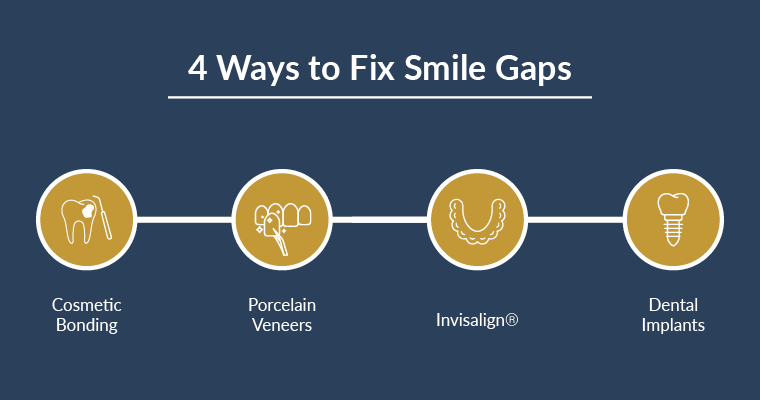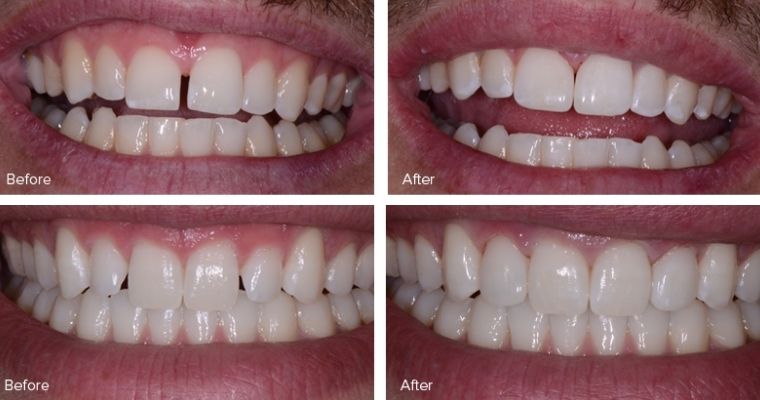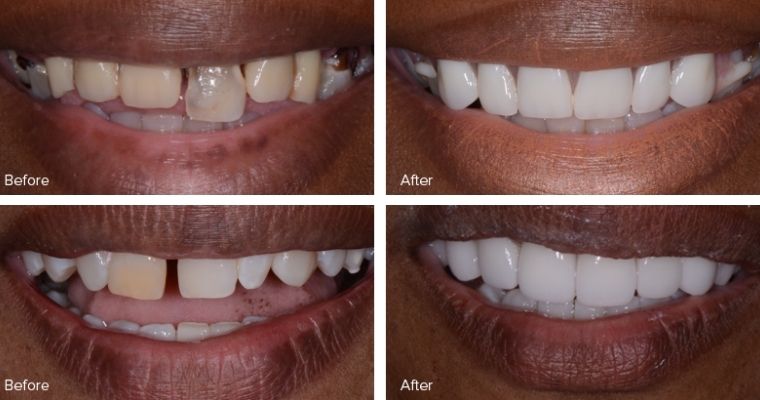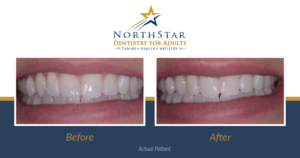How to Fix Gapped Teeth With Cosmetic Dentistry

Do you feel self-conscious about gaps in your smile?
Besides affecting your confidence, spaces between your teeth may also affect your oral hygiene.
However:
Thanks to modern cosmetic dentistry, your dentist can easily fix gaps between teeth and improve your smile.
In this blog, you’ll learn about your options, including:
- Cosmetic bonding
- Porcelain veneers
- Invisalign®
- Dental implants
Let’s get started.
1. Cosmetic bonding
Cosmetic bonding, otherwise known as dental bonding, is a quick way to fill gaps between teeth!
A tooth-colored resin is applied and hardened with a special light.
The best part?
Cosmetic bonding can be done in as little as one visit.
Check out real patients’ before-and-after transformations below!
2. Porcelain veneers
Veneers are custom-made, thin shells of porcelain material that hides a variety of smile flaws.
Veneers transform your smile completely, both in appearance and function.
In addition to hiding gaps in your smile, veneers also fix:
- Discolored, stained, or dull teeth
- Teeth that are worn down, cracked, or misshapen
- Misalignment
- Small or undersized teeth
On average, porcelain veneers may take two appointments. After your initial consultation, your dentist will send out impressions of your teeth to a dental lab.
In the meantime, you’ll wear temporary veneers to test out your new smile.
Then, your dentist will bond the shells to the front surface of your teeth.
This is a real before-and-after porcelain veneers case at NorthStar Dentistry for Adults.
3. Invisalign
Invisalign is a great option to fix gapped teeth.
It’s a modern orthodontic treatment that uses a series of clear aligners to move your teeth into optimal positions.
Invisalign closes gaps between your teeth while simultaneously straightening out your smile. It’s able to reduce gaps permanently and discreetly.
The treatment timeline varies between patients.
On average, it’ll take 12-18 months, which is faster than traditional braces.
4. Dental implants
Close bigger gaps (usually a result of missing teeth) with dental implants.
A dental implant consists of a:
- Implant post
- Abutment
- Restoration (either a crown, bridge, or denture)
Dental implants close gaps in your smile by acting as your natural tooth root. Once placed into your jaw, the healing process may take anywhere between three to eight months.
This prevents your surrounding teeth from shifting.
It’s a great restoration option that will be topped by a crown, bridge, or denture, depending on how many teeth you’re missing.
In addition to enhancing the appearance of your smile, it also restores function. You’ll be able to talk and eat normally again!
Should I fix my gapped teeth?
While this is a personal choice aesthetically, there are health benefits to closing spaces between your teeth.
For instance:
Gaps leave lots of room for food and debris particles to get stuck, especially in hard-to-reach areas.
Plaque and harmful bacteria develop quickly, causing tooth decay or gum disease.
In addition:
Your surrounding teeth will naturally shift out of place, which leads to misalignment and worn-down teeth.
Scheduling a consultation with your cosmetic dentist is the best way to see how you can fix gaps in your smile.
Bonus:
If they offer intra-oral preview technology, you’ll see a preview of your new smile so you can make the best decision for yourself.
NorthStar Dentistry for Adults is proud to offer the latest technology to accommodate for all of your smile needs.
What causes gaps in teeth?
A gap between your teeth is more common than you think.
It may result from:
- Gum disease
- Oversized labial frenum
- Genetics
- External physical force
Gum disease
Poor gum health results in receding gums, gum infection, and loose teeth.
Untreated gum disease may cause your teeth to shift, creating gaps.
Oversized labial frenum
Although you may not have heard of this, it’s a common cause of gaps in between your front teeth.
The labia frenum is a thin piece of tissue that connects your upper lip and upper gums.
Sometimes, it doesn’t grow normally.
When your frenum is oversized, it causes your front teeth to separate, creating a gap.
Genetics
Your genetics determine… well, basically everything.
From your jaw size to your teeth size, genetics affects spacing in your smile.
For example:
If you have a larger or wider jaw than average, your teeth will have room to move around and shift.
It’s also possible to develop gaps later in life.
This can occur if you get a tooth extracted, opening up space for your teeth to move.
External physical force
External physical force ranges from sucking your thumbs as a child to dental trauma.
Other external forces on your teeth may cause gaps, such as thrusting your tongue towards your teeth when eating.
Looking to fix your gapped teeth in Huntersville, NC?
Finding the best cosmetic dentist near you is the first step to fixing smile flaws, including gaps.
If you live near Huntersville, schedule a consultation with our award-winning and patient-favorite dental office.
Our skilled dentists, Dr. David Bunn and Dr. John Merrill, are ready to give you the smile you’ve always wanted. Facing extensive dental problems? Don’t worry, our full mouth restoration service has you covered.
Or reach us by:
- Calling us at: 803-525-0827
- Emailing us at: [email protected]
Our office is based out of Huntersville, NC… opens in a new window to Google Maps…, and serves patients from all over North Carolina, including Cornelius, Charlotte, Davidson, Rock Hill, Fort Mill, Gastonia, and Concord, NC.





